Even while every animal in the animal kingdom plays a major role in our environment, some of them are not particularly aesthetically beautiful. Of course, everyone has their own definition of beauty, so what one person finds to be the ugliest animal may not be considered by another to be so.
Every animal has a purpose, and every creature matters, even if they don’t all have the same adorable, fuzzy, or flamboyant appearances as a cat, dog, peacock, or large panda.
An animal’s ugly appearance may be physical in nature (such as having odd body parts and filaments) or result from its way of existence. For instance, Marabou storks, which eat dead animals, are frequently spotted covered in blood.
Some animals can survive in harsh habitats because of unattractive features, and studying them can improve our understanding of ecosystems.
While ugliness and attractiveness are somewhat arbitrary, there are times when the majority of people seem to agree – “This is one weird-looking thing”.
In light of this context, let’s look at our selection of the top 15 ugliest animals in the world and if they are dangerous to humans!
Meet the Ugliest Animals in the World
1. Naked Mole Rat

Without the naked mole rat, a list of ugly animals would be incomplete. The naked mole rat is unquestionably the ugliest animal in the world that shouldn’t have ever existed. You’d almost wish to be blind since they are so ugly.
Other than their truly ugly look, naked mole rats are unique animals for a variety of other reasons. The first thing to note about them is that they are the only rodents that are almost completely hairless and have bodies that are well-suited for living underground.
Their body is covered in a small number of tiny hairs that work as whiskers to help them sense their surroundings. Surprisingly, naked mole rats are not closely related to either moles or rats, but rather to porcupines, chinchillas, and guinea pigs.
Here are some intriguing facts about these horrifyingly strange creatures. East-Central Africa is where you can find naked mole rats.
Mole rats in their natural state lack the neurotransmitters necessary to experience pain. These moles have a maximum lifespan of 32 years.
The average colony size for naked mole rats is around 75 miles, and they typically reside in groups of 20 to 300. They primarily eat big tuber plants.
| Scientific Name | Heterocephalus glaber |
| Size | The average length and weight of a naked mole-rat is 3 to 4 inches and 1.1 to 1.2 ounces (30 to 35 grams), Although queen naked mole-rats can weigh up to 1.8 ounces. |
| Animal type | Rodents. |
| Found In | Ethiopia, Somalia and Kenya. |
| Are They Vicious? | Naked Mole Rats are not dangerous to people. |
| Conservation Status | The Naked Mole Rat is categorized by the IUCN as Least Concern because there are many of them in their range and they are not considered to be endangered. |
2. California Condor
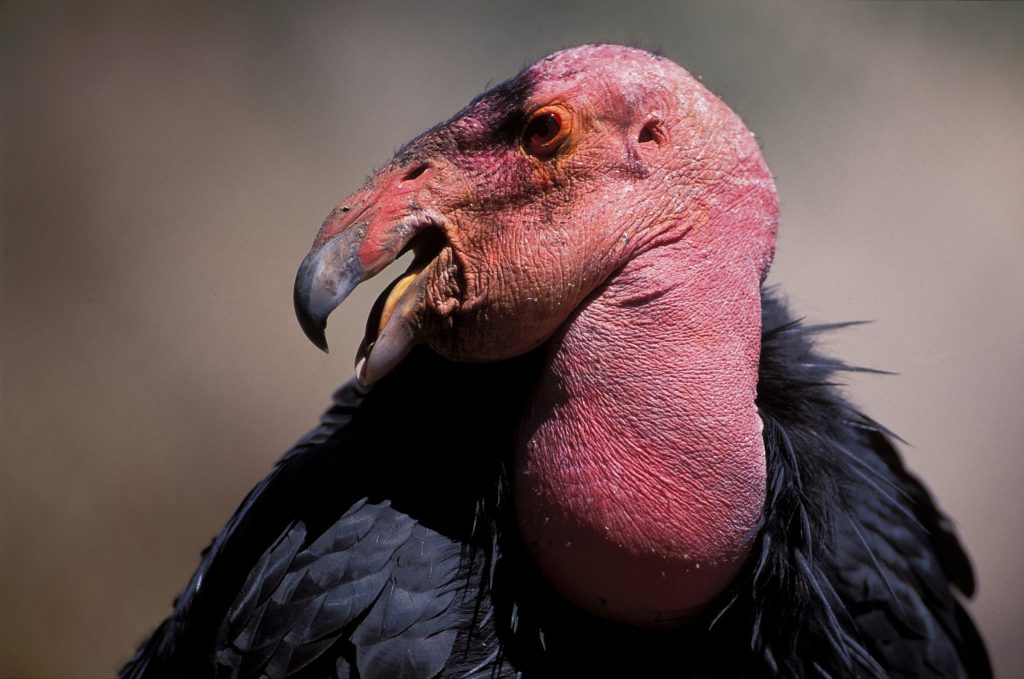
The California condor, one of the rarest birds in the world and the largest flying land bird in North America, soars gracefully above the canyons and deserts of the American West.
However, this bird isn’t particularly photogenic up close. A feathered head would become clogged with blood as the bird eats on huge rotting flesh, therefore the bald head is an adaptation for its lifestyle as a scavenger.
In the 19th and 20th centuries, human activity, lead poisoning, and the use of pesticides like DDT nearly wiped out the California condor population. In the late 1970s, the birds were on the verge of extinction; by 1981, there were only 22 birds left.
| Scientific Name | Gymnogyps californianus |
| Size | Wingspan up to 9 1/2 feet and weighing up to 23 pounds. |
| Animal type | Vulture |
| Found In | California to Florida and Western Canada to Northern Mexico. |
| Are They Vicious? | California condor isn’t harmful to anything that isn’t already dead. |
| Conservation Status | Critically Endangered |
3. Proboscis Monkey
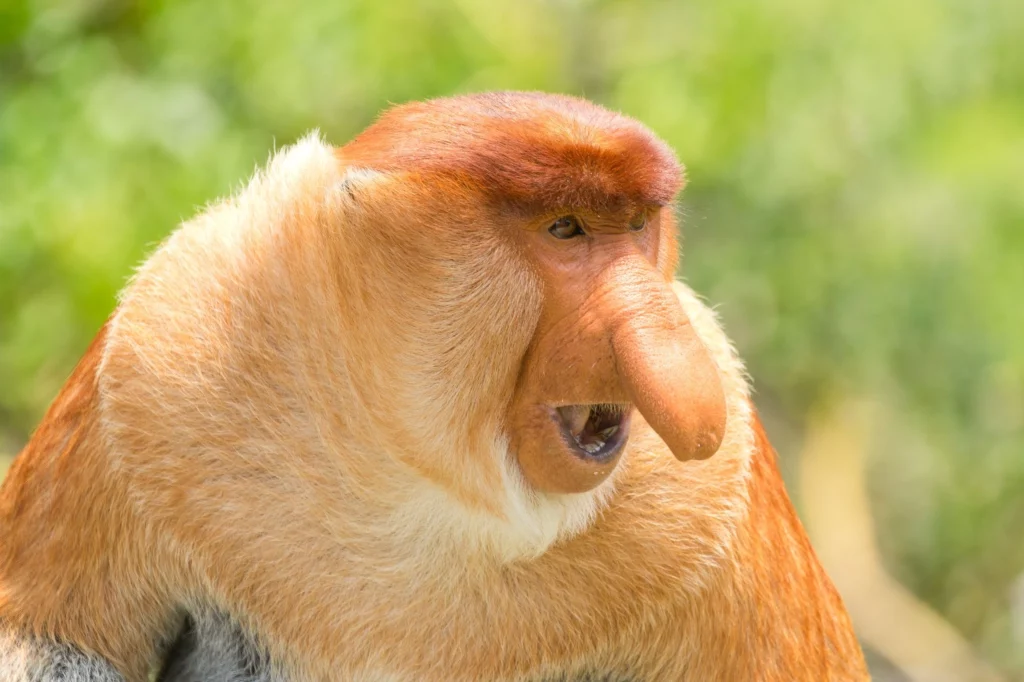
After discussing ugly animals from the water and rodents, let’s discuss “proboscis monkeys,” a less well-known animal from the earth. If you ask us, we actually like monkeys and think them to be fascinating and entertaining animals to watch. Nevertheless, there is a particular species of monkey that is not attractive to look at and is not like the others.
The old-world monkey is another name for the proboscis monkey. Long-nosed monkey, orang belanda, monyet belanda (meaning Dutchman or monkey), and nasalis larvatus are some of the names that they go by.
In Indonesia and Borneo, an island in Southeast Asia, they are primarily found in mangrove swamps, riverine forests, and swamplands. It primarily inhabits lowland areas close to water.
Proboscis, which refers to an animal with a long nose, is the term given to them because of their long noses. The noses of male monkeys hang past their mouths because they have longer noses than females do.
The primary components of the proboscis monkey’s diet are insects, flowers, fruits, seeds, leaves, and bark. They are therefore listed as an endangered species.
| Scientific Name | Nasalis larvatus |
| Size | Typically 70 cm and 22 kg |
| Animal type | Primate |
| Found In | Only found on island of Borneo, and in areas of Brunei, Indonesia, and Malaysia, the three countries that divide the island. |
| Are They Vicious? | Serious violence is rare in these monkeys, small aggression does occasionally occur. |
| Conservation Status | The IUCN Red List of Threatened Species lists the proboscis monkey as endangered. |
4. Blobfish
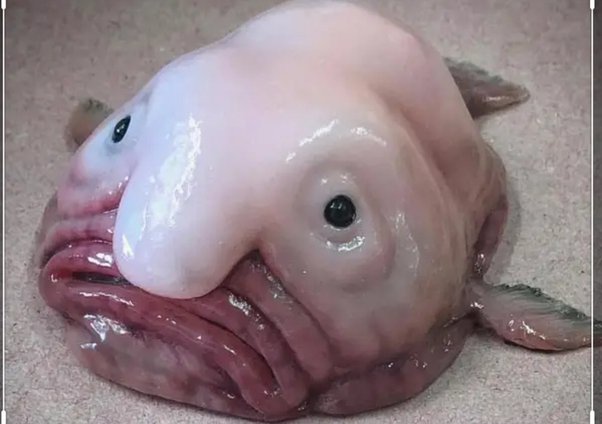
Yes, we are back with yet another sea creature blobfish. Since 2013, the blobfish has been ranked as the most ugly animal in existence by the Ugly Animal Preservation Society.
This aquatic monster looks like a chunk of slimy slop and has no muscles. Blobfish is undoubtedly one of the ugliest animals on the planet. Since it is simply a lump of gelatin, the name is appropriate.
Blobfish are no exception to the rule that slimy appearances are always odd to look at since they make it difficult to not feel repulsed. The appearance of a Blobfish is similar to a ball of slime with two eyes and a large nose. But in its natural habitat, the blobfish appears less like a blob and more like a spiky, spiny deep-sea animal.
Off the shores of Australia and Tasmania, blobfish dwell between 2,000 and 3,900 feet below sea level. The blobfish has no bones and appears somewhat pasty as it emerges from the extremely pressured depths where it lives.
| Scientific Name | Psychrolutes marcidus |
| Size | Typically 30cms, 20 pounds |
| Animal type | Psychrolutid fish |
| Found In | Southwest Pacific, Deep sea. |
| Are They Vicious? | Luckily, the blobfish does not pose a serious hazard to people. |
| Conservation Status | Not extinct |
5. Giant Salamanders
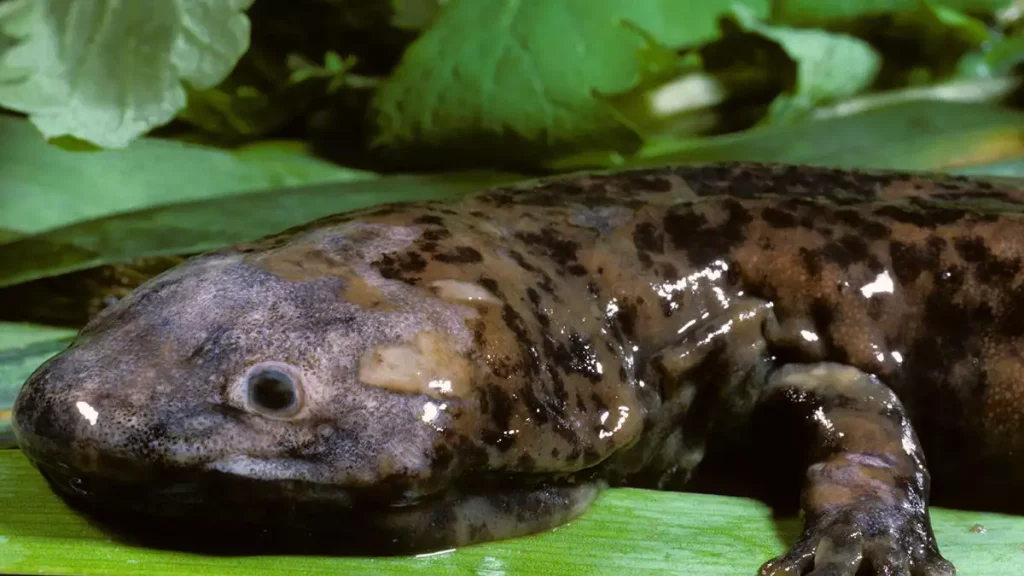
If you ask us, we think all amphibians, including salamanders, toads, and frogs, have some ugly features. They are not very attractive due to their slimy bodies.
Giant salamanders are extremely ugly, having broad bodies and big skulls. They also lack eyelids. At the sides of the face, these have loose skin. Salamanders breathe via their skin since they are amphibians.
Mucus is smeared all over their skin. When on land and while swimming, the giant salamanders benefit from this slimy substance’s ability to keep parasites at bay.
Among all amphibians, Chinese giant salamanders have the longest lifespan. When in danger, the Japanese giant salamander secretes something that smells like Japanese pepper. All kinds of salamanders produce the secretion, and it is effective at keeping predators away.
| Scientific Name | Cryptobranchidae |
| Size | The average length and weight is 60-70 cm, 5-6 kg. |
| Animal type | Amphibian |
| Found In | China, Japan, and the eastern United States |
| Are They Vicious? | Salamanders are not dangerous to humans, instead, they are timid and completely harmless. |
| Conservation Status | This salamander, despite its status as “giant,” is now critically endangered as a result of over harvesting for human food, habitat loss, and water pollution. |
6. Elephant Seal
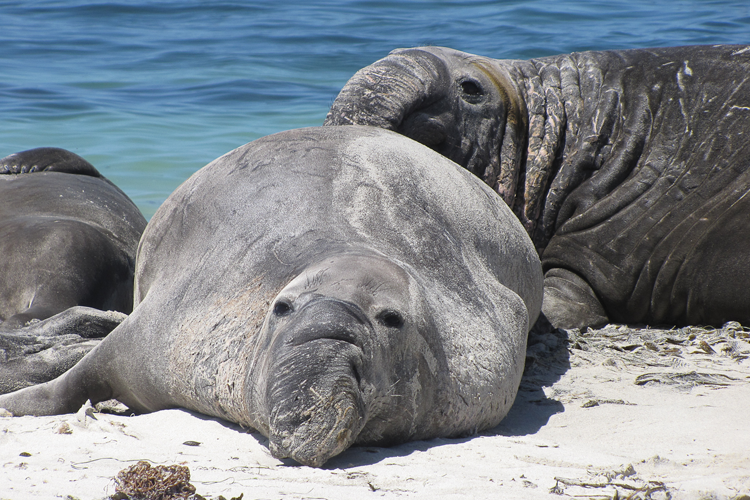
One of the cutest animals on earth are young elephant seals. They have been the main draw of aquatic zoos all over the world. The adult male species of elephant seals, however, does not fit this description.
The typical lifespan of an elephant seal is 21 years (Southern Elephant seals). By the age of 7-8, male elephant seals (bulls) exhibit a number of distinctive traits that aren’t present in the female population. These traits include a larger chest region and a proboscis, which is a long, floppy nose.
Elephant seals often lack external ears and have huge, round, black eyes as well as facial whiskers. They are protected from the intense cold by the blubber that covers their bodies. However, it has a huge impact on how they travel on land.
| Scientific Name | Mirounga leonina |
| Size | On an average they are up to 4,000 pounds and 20 feet in length |
| Animal type | Marine Mammals |
| Found In | The eastern and central North Pacific Ocean |
| Are They Vicious? | Elephant seals may bite and have very huge, sharp teeth. They are carriers of bacteria that can affect both people and animals very seriously. |
| Conservation Status | Northern elephant seals are not currently endangered. |
7. Horseshoe Bat
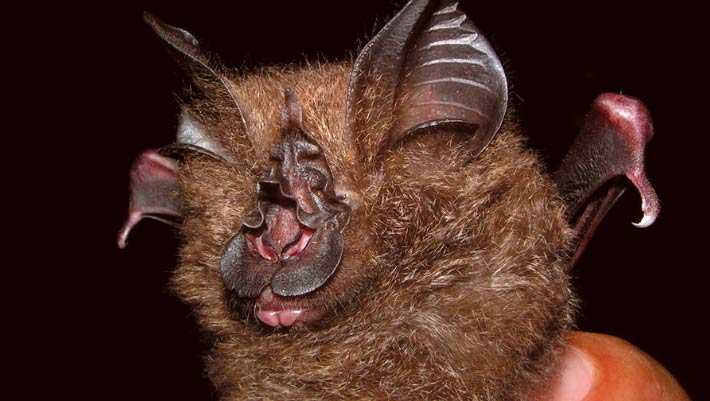
Horseshoe bats in general definitely include a number of species that could compete for this position among the top 15 ugliest creatures on the planet. Mega bats like this one with a long face can be found in West and Central Africa. It also goes by the names big-lipped bat and fruit bat with a hammerhead. With a wingspan of almost 3.3 feet, hammer-headed bats are the biggest bats in Africa.
They are a highly sexually dimorphic species of bat due to the stark differences in appearance between the sexes.
Due to their nature as fruit bats, they regularly eat fruits like bananas, figs, and mangoes in big numbers. On fruit farms, nevertheless, these critters are regarded as pests. This bat is even hunted by locals for food because it is considered as bushmeat.
| Scientific Name | Hypsignathus monstrosus |
| Size | Weight 330 g; Length 20 – 28 cm |
| Animal type | Megabat |
| Found In | Tropical and temperate climates from Europe to Japan and from Asia to Africa. |
| Are They Vicious? | Coronaviruses are known to be carried by horseshoe bats. The genomes of SARS-CoV and SARS-CoV-2 share striking similarities with the coronavirus genomes found in these bats, leading to the well-established notion that these viruses may have their origins in horseshoe bats before evolving and spreading to humans. |
| Conservation Status | Not extinct |
8. Warthog
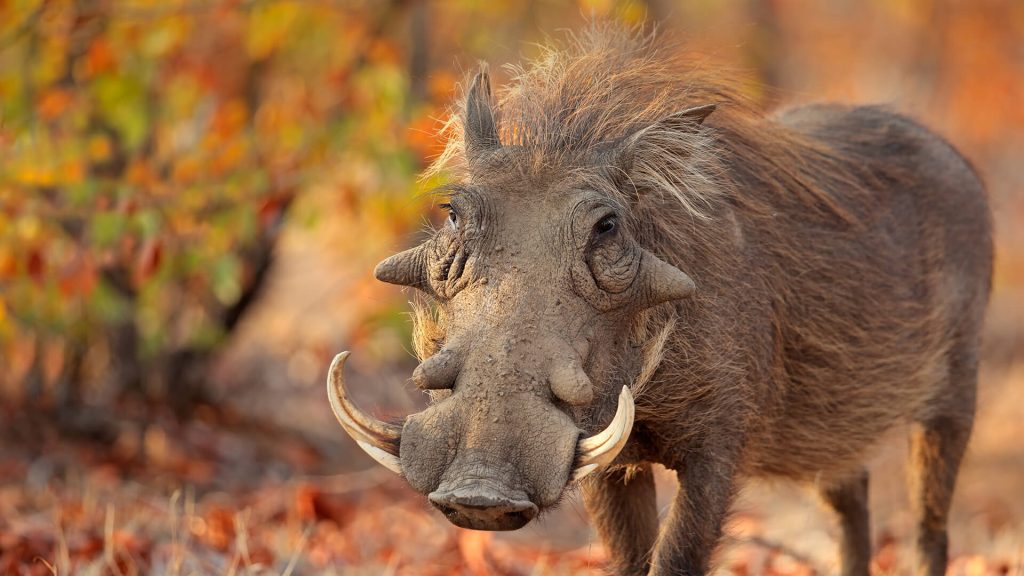
Warthogs are common in the African savanna south of the Sahara and are a member of the pig family and this ugly animals name list would be in complete without mentioning them.
There are two recognized species of warthogs: common warthogs and desert warthogs. The latter is a little bit smaller than its counterparts and is only found in a restricted area of East Africa.
They have huge heads, long noses with features resembling warts, and prominent tusks, which are physical traits common to pigs. Two sets of tusks are present on common warthogs.
Their upwardly curving top tusks protrude from their jaws. They are slightly below lower tusks, which are shorter and less noticeable. The animal has rough or prickly body fur.
Despite the fact that these features make warthogs ugly, they enable them to thrive in the African grassland environment.
| Scientific Name | Phacochoerus africanus |
| Size | Weight 60-80 cm in height and 1.3-1.8m in length; 60 and 150kg |
| Animal type | Mammalia |
| Found In | Grassland, savanna, and woodland in sub-Saharan Africa |
| Are They Vicious? | Warthogs are not aggressive creatures, they often pose no threat to people. When threatened or cornered, a warthog may attack to defend itself. |
| Conservation Status | Warthog is listed as Least Concern by the IUCN. |
9. Titicaca Water Frog
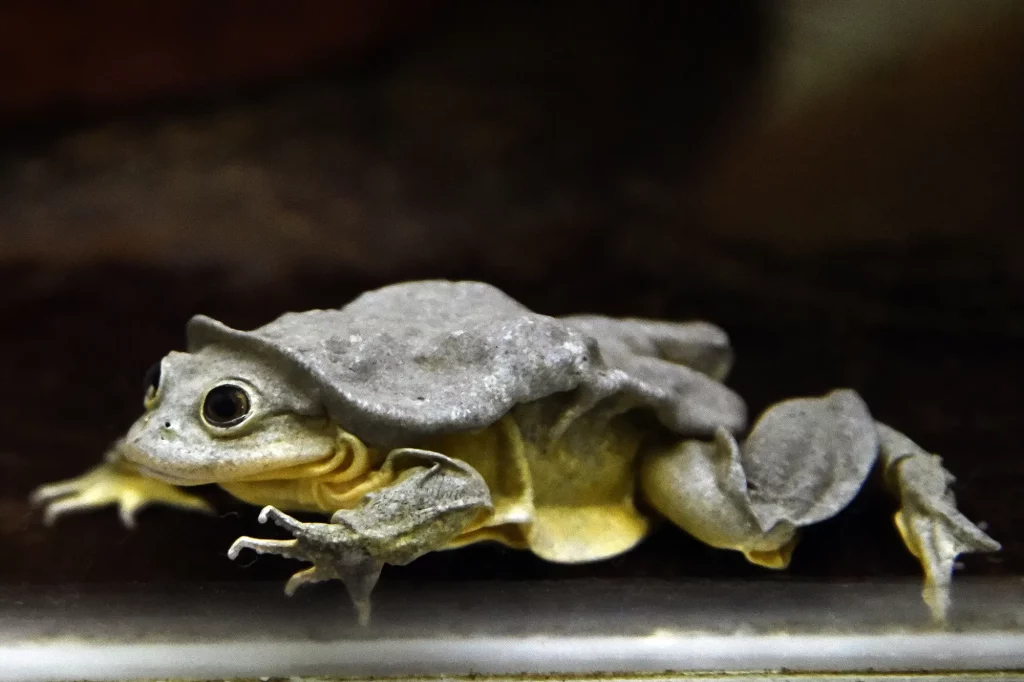
The lakes in the Andes highlands are home to the permanently aquatic amphibian known as the Titicaca frog. These lumpy, ugly, dark-colored frogs can live up to ten years and can reach lengths of up to eight inches.
This frog species known to grow up to 0.5 meters long, is found in the high Andes near Lake Titicaca. It’s loose, floppy skin that ripples around its body in folds has earned it the nickname “scrotum frog.”
The Titicaca frog deserves to be on this list just for its name alone! According to theory, the frog’s skin folds provide it with more surface area so it can take in more oxygen from the lake’s water.
| Scientific Name | Telmatobius coleus |
| Size | Length 20 cm and 2 pounds |
| Animal type | Rodents. |
| Found In | Titicaca basin |
| Are They Vicious? | The water frogs of Titicaca have no known negative impact on people. |
| Conservation Status | The Titicaca water frog is listed on the IUCN Red List as being “Critically endangered.” |
10. Hyenas
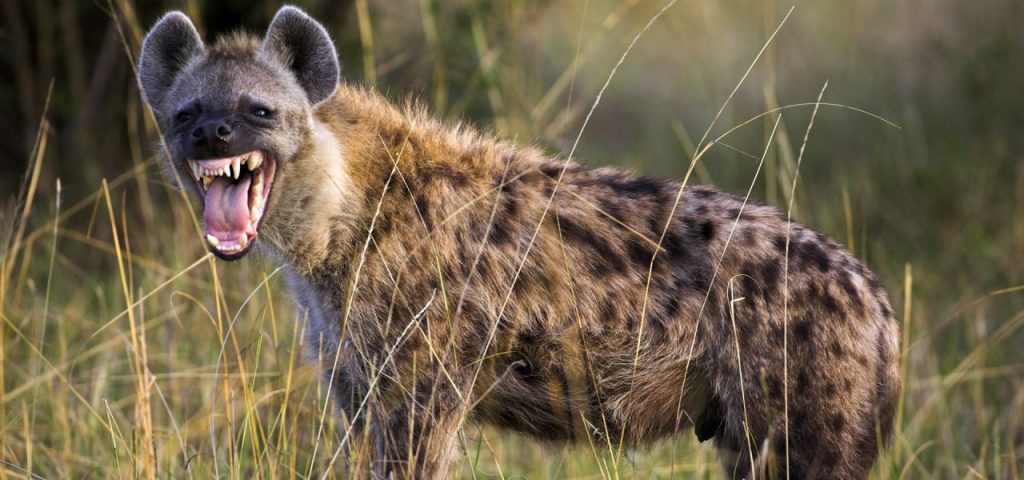
The hyena is another animal that made our list of the ugliest animals. Their body parts are used for therapeutic purposes, giving them a bad reputation tied to witchcraft.
In some traditions, hyenas are also linked to grave robbery, kidnapping, and the theft of cattle.
Hyenas seem to be a hideous combination of a dog and a fox. Although they have heads that resemble dogs, when they show their teeth, they appear to be laughing.
However, this does not make them amicable. On the contrary, they treat their prey brutally. Even lions are afraid to go close to hyenas.
Hyenas don’t have an issue eating leftovers and dead animals, unlike other predators. An interesting fact about hyenas is that not even the king of the jungle wants to hunt them.
| Scientific Name | Hyaenidae |
| Size | Average weight of Hyena is 44 – 64 kg, Height: 70 – 92 cm, Length: 95 – 170 cm |
| Animal type | Mammal |
| Found In | North and northeast Africa, the Middle East, and Asia, all the way to southern Siberia |
| Are They Vicious? | Hyenas are dangerous to humans. Attacks by hyenas often target women, children, and elderly men, although both species have been known to occasionally target healthy adult males as well. |
| Conservation Status | Not extinct |
11. Marabou Stork
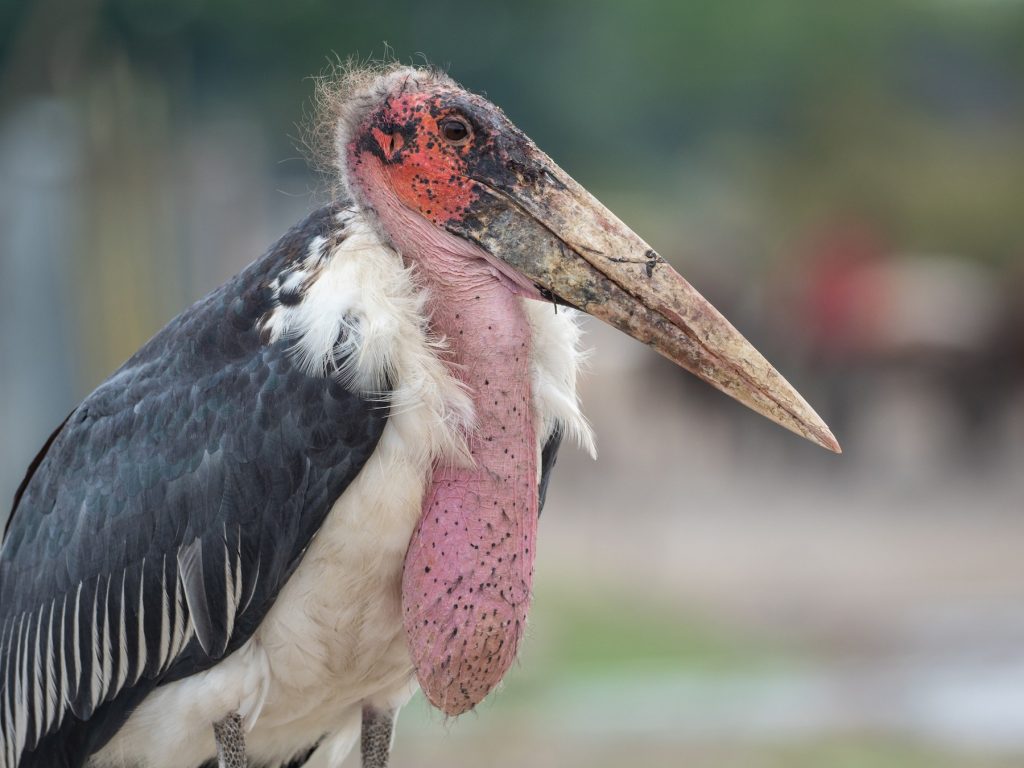
The Marabous stork is a species of stork that is indigenous to Africa. It is also referred to as an “undertaker bird.” These birds can weigh 20 pounds and grow to a height of 60 inches. Their wingspan can reach heights of up to 12 feet.
Marabou storks are not only gigantic but also horrifyingly ugly. Their nickname, “undertaker birds,” refers to the fact that they look to be dressed in a large black coat when viewed from the back.
The Marabou stork is a scavenger and opportunistic feeder who will eat nearly any animal remains, including feces, dead flesh, and leftover pieces of meat. It occasionally consumes pelican chicks as well as other birds like pigeons, doves, and flamingos.
| Scientific Name | Leptoptilos crumenifer |
| Size | The average length and weight of a Marabou Stork is 1.2 – 1.3 m and 4.5 – 8 kg |
| Animal type | Wading bird |
| Found In | Sub-Saharan Africa |
| Are They Vicious? | Marabou Stork is not known to attack humans |
| Conservation Status | Marabou storks are not endangered at present |
12. Star-Nosed Mole
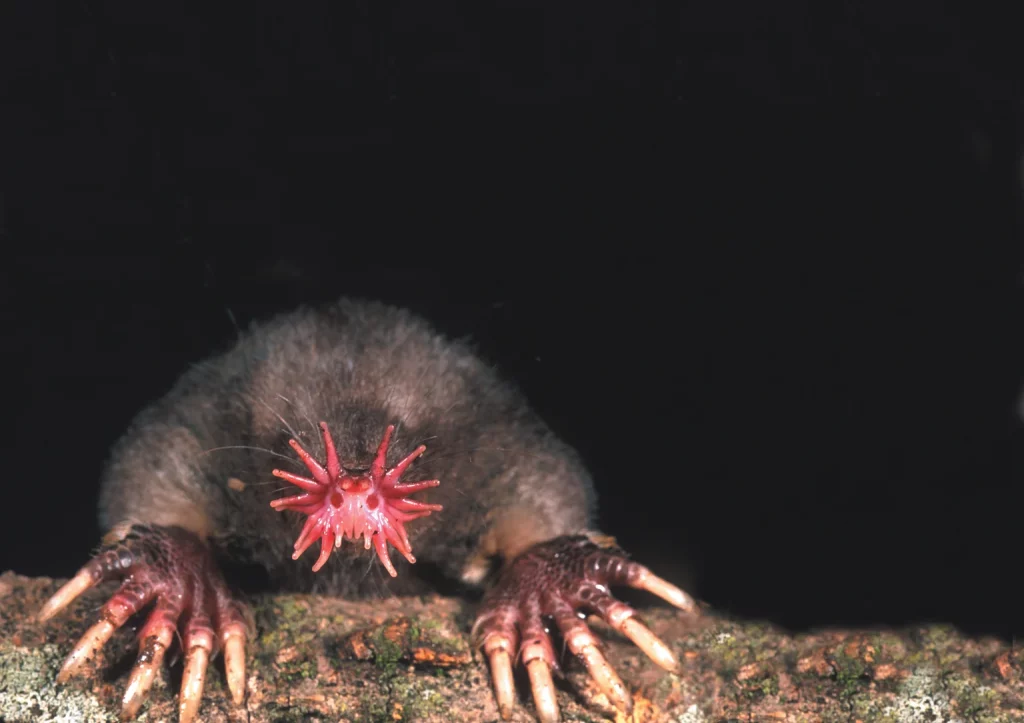
Star-Nosed Mole is one of the ugliest animals on earth. They are creepy and ugly, and they appear like they should be the theme of a 1950s horror movie.
The northern United States and parts of Canada are home to the tiny, burrowing star-nosed mole. Star-nosed moles can smell even underwater and have about 22 fleshy appendages surrounding their noses.
They are also known as the fastest-eating mammals. The star-nosed mole can recognize and eat its prey in as few as 120 milliseconds, and they typically take 227 milliseconds on average.
Each of its “rays,” or fleshy tentacles, has 100,000 nerve endings, whereas the human hand only has roughly 17,000 nerve endings.
Therefore, the rays of the star-nosed mole are the most sensitive organs in the entire animal kingdom. Additionally, the mole uses these odd small feelers to sense seismic wave vibrations.
They have great swimming abilities and can even withstand spending up to 30 minutes underwater.
| Scientific Name | Condylura cristata |
| Size | The average length and weight of a star nosed mole is 12 cm and 49 g |
| Animal type | Semiaquatic mole |
| Found In | Woods, bogs, marshes, and fields, moist, low areas in the northern parts of North America |
| Are They Vicious? | Star-nosed moles are not dangerous to humans |
| Conservation Status | According to IUCN, this species is classified as Least Concern. |
13. Purple Frog
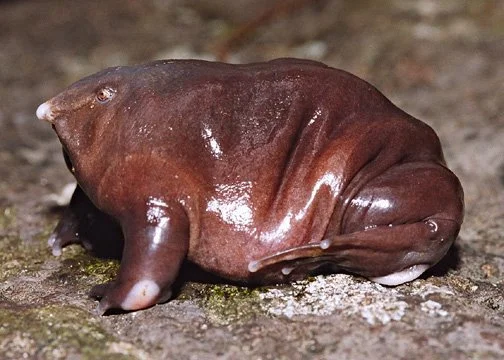
Guess which amphibian is the odd one out? It’s a frog in purple. This frog is purple in a world where frogs are typically green and brown. As a result, in comparison to the other frogs, it is awful.
Amphibians are typically disliked because of their weird look and slimy skin. This one, though, takes the lead because of its uncommon color and a small head.
The purple frog also has smaller eyes and an exceptionally pointed snout. The purple frog’s tiny eyes have horizontal pupils, and its body has the appearance of a balloon that has been filled with gas.
The Western Ghats of India is home to the purple frog, also referred to as the pig nose frog.
Purple frogs are listed as an endangered species, regardless of how ugly they may appear. They may appear bloated, and slimy, have strangely curved noses and exhibit unusual greyish-purple skin. Hopefully, people will contribute to keeping these amazing creatures alive.
These animals live underground and spend the majority of their time hidden in underground burrows, so it appears as if he is aware of his terrible look as well.
The purple frog feeds on termites, worms, and ants to survive. Purple frogs only emerge from hiding during the mating season, which lasts for around two weeks, so you must be wondering why you rarely see them.
| Scientific Name | Nasikabatrachus sahyadrensis |
| Size | About 7 centimeters |
| Animal type | Amphibians |
| Found In | The southern Western Ghats of India |
| Are They Vicious? | The purple frog is not poisonous, to be clear. In reality, the frog is frequently harvested for food by locals. |
| Conservation Status | The IUCN Red List classifies the purple frog as Endangered, and it faces threats from local communities’ eating of it and deforestation caused by growing farming. |
14. Monkfish
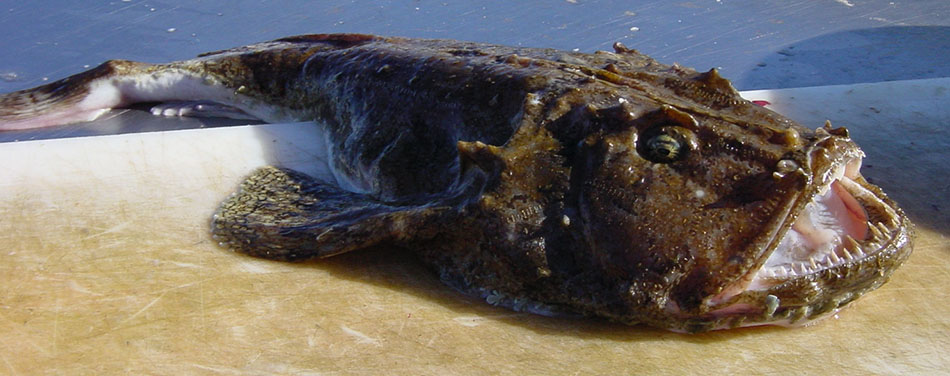
The “sea devil” itself is yet another aquatic critter on our list of nasty animals. We are discussing the monkfish. The “naked mole-rate” of aquatic life is the monkfish.
Although it is well known for producing delicious meat, this sea creature is not particularly attractive to look at. The monkfish tail is also only eaten as a meal because it is nasty to look at.
Due to its frog-like appearance and unusually ugly face, it is often referred to as the sea devil or the frogfish. The monkfish has a broad, flat skull and eyes that are too small for its head, to put it simply. Its appearance is enhanced by the fish’s gaping mouth and pointed teeth. Typically, a sea devil’s body is smaller than its head.
It has tiny spines all over its head as well as a big, thin horn on top of its head known as an esca. The fact that the spines resemble seaweed or algae helps them blend in with the water.
Monkfish’s ghastly exterior is due in part to its slimy body. All of this enhances its capacity for survival, though, as it can easily skulk beneath the water.
| Scientific Name | Monkfish |
| Size | The average length and weight of a monk fish is 2 to 4 feet and 50 pounds. |
| Animal type | Anglerfish |
| Found In | Western North Atlantic, ranging from Newfoundland to North Carolina |
| Are They Vicious? | Due to the discovery of some potentially deadly imported puffer fish marketed as monkfish, the FDA has issued a warning to people not to eat monkfish |
| Conservation Status | Not extinct |
15. Aye-Aye
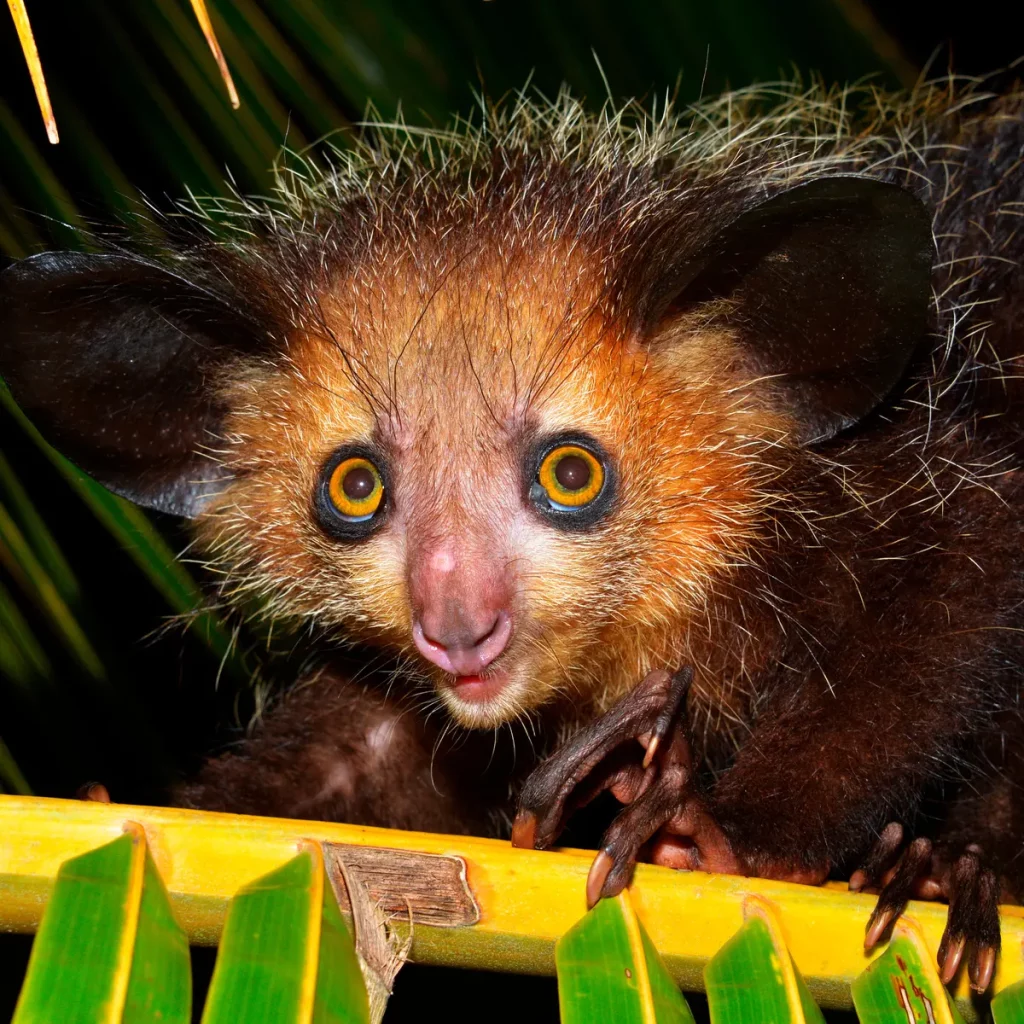
Another animal that failed the genetic lottery is the aye-aye. It was added to our list due to its strained look and demeanor. Some people even think they are adorable and “aww-worthy” creatures, but we disagree completely.
Nobody is entirely certain how they came up with their unusual name, but aye-ayes undoubtedly caught everyone’s attention. Some people believe that it was called after a French naturalist who exclaimed upon viewing them. Others believe that the name given to them means “don’t know” in their native tongue. Regardless of the circumstances, the aye-aye has made our list.
The aye-aye has long middle fingers, large, vivid orange eyes, and rodent teeth that never stop growing.
Fortunately, they are distant relatives of Madagascar-born lemurs. Although not the cutest, this small species has some fairly excellent survival skills. The largest nocturnal primate in the world, the aye-aye forages for food at night.
| Scientific Name | Daubentonia madagascariensis |
| Size | The average length and weight of Aye-aye 2.5 – 3.3 ft and 4lbs – 6lbs |
| Animal type | Primate |
| Found In | Madagascar East Cost |
| Are They Vicious? | Not at all, instead, it is a perfectly harmless creature that is often killed on sight. |
| Conservation Status | Aye- aye is currently classified as Endangered by the IUCN. |
Hugues Beaufrere is the Exoticpetia’s senior writer and reptile expert. He has been fascinated by reptiles and monkeys since he was a kid and had years of experience in herpetology and primatology. He has cared for various kinds of Monkeys, Lizards and Reptiles and loves to share his knowledge and passion with others.


